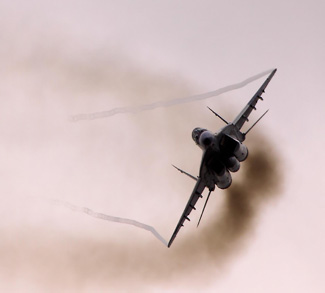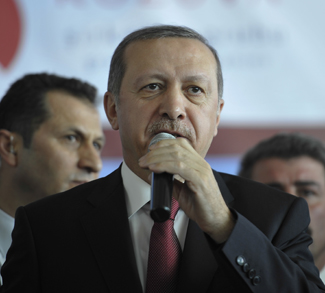Russia continues to seek to increase its influence in the Middle East region’s power-brokering structure to a level it believes to be appropriate for its traditional great power status. As one Russia-watcher recently described, “Russia seeks the same level of say in the global system as it had at the Yalta conference of 1945.” It is important to look at Russia’s broader moves in the Middle East, like in Egypt, and not just Syria to properly understand the evolution of Russia’s resurgent great power foreign policy.
The Russian leadership’s disregard for what the West prefers in the Syrian peace process is the most visible example of this desire. Russia has been continuously marketing itself as the stronger, more consistent and more beneficial ally to have in the region today. This strategy has included taking the pragmatic-realist approach in helping countries combat domestic strife, terrorism, and regional pressure; compared to the United States’ emphasis on democratic values and better governance. One of Russia’s most blatant spearheads is Russian engagement with Egypt. Forty-four years after President Anwar Sadat expelled Soviet advisers from the country, Russia’s influence is on the rise once again.
It has not been an entirely smooth reengagement for Russia and Egypt. The October 2015 downing of Russia’s Metrojet 9268 over the Egyptian Sinai Peninsula still serves as a point of tension between the two countries. A travel ban was put in place by Russia soon after the crash, and a public disagreement over the cause of crash as well as a slowdown in once hot joint anti-terror exercises have all been noted. However, these issues have become nearly inconsequential in the larger geopolitical relationship between the two countries. Egypt is Russia’s second doorway into the region and it is unlikely to be a fleeting relationship.
Wikistrat experts in a December 2015 simulation pointed towards Russia’s heavy engagement with Sisi’s Egypt, while simultaneously conducting its Syrian campaign, as an important example of Russia’s renewed attempts to insert itself into the region with its pragmatic-realist approach. The large volume of military arms sales between Egypt and Russia is a high profile and highly successful example of Russia’s influence-building efforts. These arms sales have been augmented by the 2015 landmark nuclear infrastructure development deal, and numerous counter-terrorism exercises, and Russia’s attempts at engaging Egypt in the Syrian conflict. All of these actions are indicative of Russia’s attempts to create the perception that it is a growing viable alternative to the United States as a partner for Egypt.
Russia was also keen to bring Egypt to the table regarding Syria, if even symbolically. Those efforts have gone a long way towards inflating Egypt’s sense of being a major regional power with even greater power backing; something Egypt no doubt greatly appreciates. Russia has also refrained from criticizing Sisi and his government’s less than democratic tendencies while supporting harsher domestic repression in the country in the name of security. The United States on the other hand has been a keen critic of President Sisi and the failures of other governments to embrace the Arab Spring’s democratic theme. While the United States’ criticism may only have been to save domestic face, Egypt has not forgotten it and is wary of it happening again.
Russia’s resurgence in Egypt was made possible by the United States’ July 2013 decision to limit its military aid to the troubled government after a military coup ejected Mohammed Morsi. Dissatisfied with Egypt’s progress toward reinstating a democratic government, the U.S. announced that it was freezing a sizable portion of the $1.5 billion it provides to Egypt each year. The aid being withheld included 10 Apache helicopters (at a cost of more than $500 million), replacement M1A1 tank kits, and Harpoon anti-ship missiles. The U.S. also suspended the delivery of four F-16 fighter jets and canceled bi-annual US-Egyptian military exercises. The decision to freeze aid lasted until April 2015 and angered many key officials in Egypt. These officials are not likely to soon forget the sudden retraction of vital U.S. defense aid as it faced instability in the Sinai on one flank and instability in Libya on the other.
Egypt responded to the United States’ aid freeze by promptly signing arms deals with Russia worth up to $5 billion by 2015. The agreements included 50 MiG-29Ms, Buk-M2E (SA-SA-17 Grizzly) and Antey-2500 (SA-23 Gladiator/Giant) missile systems and 46 Ka-52K helicopters for Egypt’s new Mistral-class assault ships. The first MiG-29M Fulcrum aircraft are expected to be delivered by the end of 2016. These systems are crucial components for an Egypt that is looking to maintain its regional power status. The assault ships are a crucial component to any regional power projection strategy. They could serve as Egypt’s spearhead in future expeditionary ventures, like Yemen. The Mistral-class assault ships were originally supposed to be built for Russia by France. After a well-publicized injunction and rescinding of the deal, the ships were sold to Egypt. Russia wisely did not protest this sale but scored a major relations coup when they negotiated deals with Egypt to supply the systems inside of the ships and the Ka-52K naval variant scout/attack helicopters to give it teeth.
Looking into the future, it is not unreasonable to watch for these growing military ties between the two nations result in a more concrete Russian presence in Egypt. The technicians helping maintain KA-52Ks and MiG-29Ms as well as the Russian advisors and scientists involved with the 2015 nuclear infrastructure deal could serve as the initial impetus for a security presence. However, Russia’s ambitions may be even greater than a simple security complex with a small rapid reaction force. The Egyptian government has previously stated that it was ready to have Russia build a military base either in the Red Sea or the Mediterranean. Russian President Vladimir Putin has stated that Russia would seek to maintain a permanent naval presence in the Mediterranean, a region that is considered a core national interest. Experts have largely agreed that the naval facility at Tartus cannot provide sufficient support for a large naval presence in-line with Russia’s geopolitical ambitions. The facility is just too small for large ships without a major and costly expansion. “Tartus is vulnerable and not good enough and the Egyptian ports are perfect for the Russian navy,” the Times of Israel reported, quoting an unnamed Israeli defense source. An Egypt-based facility, if placed on the Mediterranean coast, could serve as a larger, more secure Tartus-like port for Russian ships. This facility could also garrison Russian military personal protecting the advisors assisting in the construction of Egypt’s nuclear infrastructure along with the personal servicing Egypt’s brand new Ka-52K helicopters for their Mistral-class assault ships and eventually their 50 new MiG-29M Fulcrums.
Through continuing and meaningful no-strings-attached security cooperation, Russia and Egypt appear to be willing to work towards developing a long-term close security relationship despite major disruptions. No matter the trials the Russia-Egyptian relationship face, arms sales and the boost they give to Egypt’s quest to be a regional power seem to keep the two close and moving forward. For Russia, Egypt is a second rail for building regional influence and offers the possibility of an eventual a tangible military facility. The relationship between the two is likely to only get stronger, not weaker as other regional analysts have suggested.




